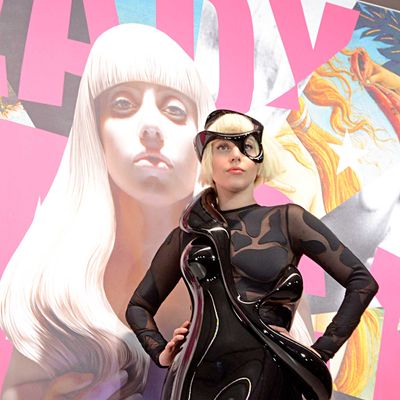
Below, a sort of social-media-era, two-person panel discussion between our art critic Jerry Saltz and the artist Matthew Weinstein ÔÇö on the nature of pop fame, art stars, and what could possibly be drawing so many celebrities into Jeffrey DeitchÔÇÖs orbit these days.
Jerry Saltz: Matthew, I know you as an artist who also used to write criticism. I looked at your Facebook page the other day and got stopped in my tracks by an amazing couple of paragraphs of something like Critical Cultural Theory. You seemed to be writing that an inversion has taken place in the flow of fame. Whereas we in the art world used to go to other sectors in order to have fame or coolness rub off on us ÔÇö to the worlds of fashion, music, movies, wherever ÔÇö now the stars of those worlds are coming to the art world for some sort of stamp of cool approval. And I think you were saying that we tend to get pretty snooty about anyone from these other worlds who comes near us, be it Lady Gaga, James Franco, or Jay Z. Do I understand you right?
Matthew Weinstein: As someone who feels optimistic about the blurring of the virtual and what we used to optimistically call ÔÇ£the real,ÔÇØ I enjoy a collapsed category. So I have no affection for any high/low binary nonsense. And I noticed a certain now-familiar reactionary art-world circling of wagons in response to the fact that certain celebrities of intergalactic fame now feel the need to sing and dance for us. IÔÇÖm not talking about Patti Smith or other beloved art/rock homegrown talents, or performers collecting as quietly as they can without dealers shrieking that they just sold something to Steve Martin. But yes, the ones you mentioned.
JS: And what do you make of those people and their new interest in us?
MW: For me, the art world  my beloved home since Columbia University made me realize I was not an art historian  always had the congeniality of a hornets nest and the glamour of a teachers lounge, so I was surprised to see famous people who could be anywhere crossing the moat. And not just cross it, but really seem to have fun inside the castle. And then entertain the castle. Then the art-world grumbling started. The same tired notions of the art world being invaded by celebrity, and the transforming of the art world into the entertainment world  blah blah blah, I cant even finish the sentence without falling asleep. But had nobody heard of the strange calculus in which the fame of a celebrity fades as the celebrity approaches the gravitational sphere of the art world?
JS: ThatÔÇÖs your theory, right? You call it ÔÇ£GagaÔÇÖs Law.ÔÇØ
MW: Okay, itÔÇÖs a crackpot theory. But donÔÇÖt crackpot theories, art, and religion all have in common the fact that they might not matter?
It used to be that an artist hitting a mid-career skid and needing to feed his (it was all his, so I use that pronoun confidently) addiction for attention would start hurling himself at the actor or celebrity of the moment to get a few secondhand butterfly kisses of fame. But now I worry about the celebrities. Really. I canÔÇÖt sleep. We seem to get them when they flatline. I like Miley Cyrus. I liked the ÔÇ£Wrecking BallÔÇØ video. She really cried, for ChristÔÇÖs sake. But I worry about her. It used to be that celebrity art took the form of the Gustave Moreau-esque face-paintings of Phyllis Diller and John Wayne GacyÔÇÖs sad clowns. Chuckled at, but not laughed at. Why a celebrity would open him- or herself up to the damning ridicule of the art world by tossing their bleeding hobby into that shark tank, I have no idea. What is wrong with being loved all the time?
JS: Are they being masochistic?
MW: I am convinced that the art world is capable of denting fame. Lady GagaÔÇÖs worst press has been around Artpop. Articles popped up about how Artpop lost money. ItÔÇÖs called Artpop. Does my theory need any more data to support it than this? (I liked Artpop.) The art world is the new cultural succubus. The phenomenon in which a celebrityÔÇÖs fame becomes increasingly hobbled as s┬¡he is drawn closer to the art world establishes the fact that there is no longer any pop culture. It is all art culture. This idea destabilizes the accepted and tired idea that Pop Art served to dissolve the art/life invisible divide. Actually, Pop Art annexed popular culture for art; thus increasing the territory for art and depriving popular culture of being perceived as anything but entertainment or decoration. The fact that huge celebrities are drawn to art-world attention proves the victory of art culture over popular culture. Celebrities cannot grasp onto art content without first offering themselves up as sacrifices to the art world. Pop Art possessed the seeds of the more conservative notions of culture and class that have grown into the world domination of ÔÇ£high cultureÔÇØ by claiming popular culture for art.
JS: Okay. Got it. And love it. I can see that money and coverage make it seem like the art world is the winner and the ÔÇ£place to be.ÔÇØ But hasnÔÇÖt the world of pop fame exploded much more rapidly? How can our tiny tribe of misfits have conquered Hollywood, the fashion world, and the record industry at once? People at the top of the pop-royalty pyramid (Kanye West and Kim Kardashian, Jay Z and Beyonc├®, etc.) ÔÇö whatÔÇÖs that about? Is there something other than the concentration of wealth thatÔÇÖs attracting these people? If so, what? And what do you think art┬ámeans to these people? To Lady Gaga, to Beyonc├®, to Kanye West? And if youÔÇÖre right that ÔÇ£the art world takes the fame out of famous people,ÔÇØ what does that mean? And mighnÔÇÖt Kanye actually be an artist?
MW: When Madonna said she was an artist, I thought, Fine, youÔÇÖre an artist. I donÔÇÖt really care about the definition of artist┬ábecause as an artist, I know from the inside that it can be a pretty shabby thing, even when it looks good from the outside, and the category of art┬ádoesnÔÇÖt, in my mind, elevate a cultural product. And yes, of course, the gravitational tug of the art world is the ÔÇ£throw like a girlÔÇØ version of real fame. IÔÇÖm speaking more crackpot/conceptually about the fact that the nebulous construction art┬áhas gobbled up culture to the point that massive celebrities need to identify with it. So it isnÔÇÖt the art world so much as the idea of art; art as this magic that levitates culture into a higher place, which the art world is selling. Art is to culture as ÔÇ£FrenchÔÇØ was to salad dressings (I have a theory about how salad dressings can define presidencies as well). It doesnÔÇÖt hurt that so much money is swirling around the art world, but I donÔÇÖt think Lady Gaga started singing to make money; so I canÔÇÖt imagine she is impressed, interested in, or needs the art worldÔÇÖs newly inherited zillions. I think her performing made her a wildly rich and famous celebrity. And if she wants to call herself an artist (does she?), fine by me. I just have that Groucho Marx as channeled through Woody Allen thing about not wanting to be in a club that wants me, so I donÔÇÖt know why theyÔÇÖd want our free drink tickets.
JS: Do you think of todayÔÇÖs collision of pop and art as also conservative? What are its conservative values? As recently as the Pictures Generation, youÔÇÖve described the great humility of artists with regard to pop culture. When and how and why did that disappear? And is the death of that humility a good thing? And finally, who is more humble, the artist or the pop star? Lady Gaga or Jeff Koons?
MW: First, in terms of ego, I think mine is as big as Lady GagaÔÇÖs, so I canÔÇÖt even imagine that of Koons. My idea of the Pictures Generation (they hate it when you call them that) was about that humility; not personal humility, but a need to drag their image files into their own hamster nests and decide that they had decoded popular culture, which isnÔÇÖt really humility, itÔÇÖs grandiosity that looked like humility in the face of neo-expressionism. Warhol had that same brand of humility but even more extreme; he was on his knees before celebrity, beauty, and the grotesque like a good Catholic. I donÔÇÖt think the art world is any more conservative today than it ever was. I think it has a confidence that it used to fake, so itÔÇÖs a little less human. Art has never been more arty. Much of this abstract painting looks so much like art, itÔÇÖs as if the message is, ÔÇ£We donÔÇÖt need you anymore, pop culture, we are art; we are going to go all Greenberg on you.ÔÇØ Of course there is no more pop culture. Everyone is now an artist. Just not everyone is a good artist.


